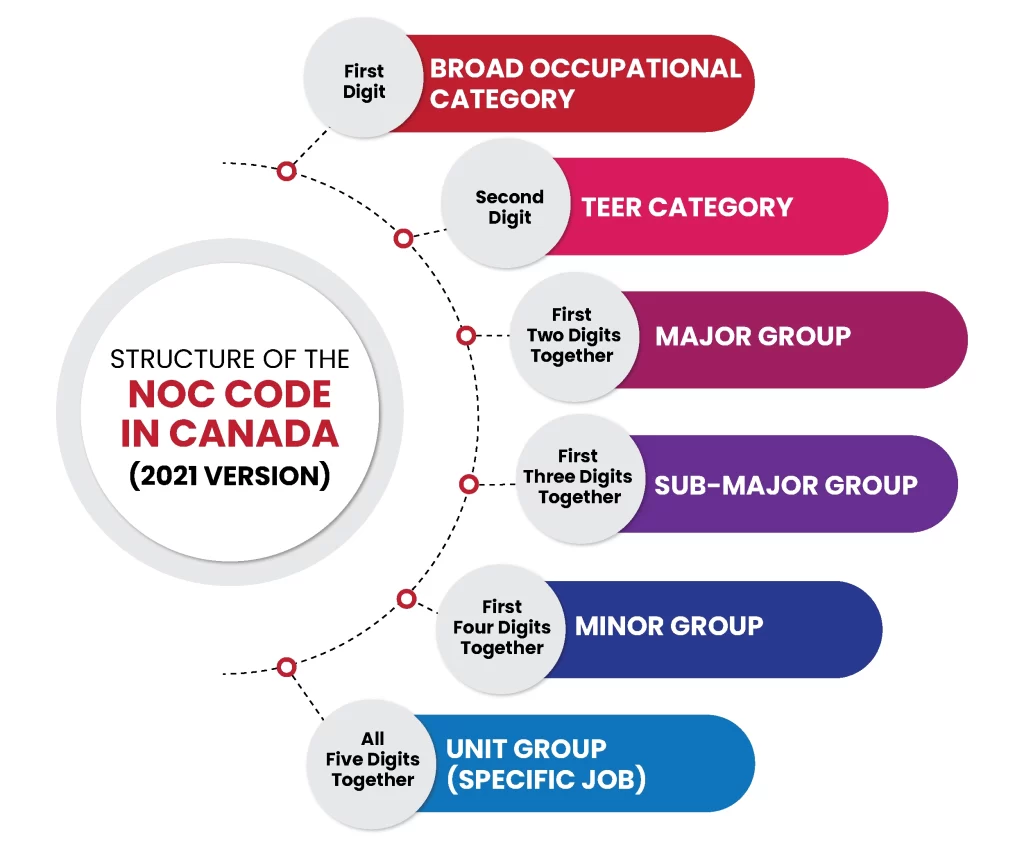If you’re a person who is job hunting in Canada or planning for Canada migration, you may have definitely come across something called “NOC code in Canada.”
Sounds fancy, right? But don’t worry—it’s actually pretty simple.
Whether you’re trying to match your skills to the right job or you’re an employer looking for the ideal hire, understanding NOC codes can make a big difference. In this blog, we’ll explain: what NOC codes are, how they work, and how they can actually help you find the job that fits you best in Canada.
Table Of Content
1What is NOC Code2Importance of NOC Code in Canada Immigration3What is the Structure of the NOC in Canada4List of NOC Codes in Canada5NOC Code Categories in Canada6NOC Codes for Express Entry and PNPs7Top In-Demand NOC Codes in Canada8How to Find Your NOC Code9Final Thoughts10Frequently Asked Questions
What is NOC Code
Let’s start with the basics, right?! What is NOC code in Canada?
NOC stands for National Occupational Classification. It’s a system that is used by the Canadian government to classify jobs based on their duties, required skills, and industry. Each occupation is assigned a unique five-digit code that helps categorize jobs consistently. The NOC system is widely used in Canada for job classification, immigration, and work permit applications.
Think of it is like a common language that connects your work experience to the Canadian labor market.
Importance of NOC Code in Canada Immigration
Understanding and correctly identifying your NOC code in Canada is important for several reasons:
Express Entry & PR Applications: If you want to become a permanent resident using the popular Express Entry system, your NOC code is the key. Canada uses this code to check if the work experience you have is actually in demand in their job market. It helps them decide if you’re eligible.
Work Permits & Visas: Planning to work in Canada temporarily? Then, immigration officials will look at your NOC code to understand your job history when you apply for a work visa. Sometimes, having a specific NOC code can even make you eligible for special immigration programs.
Provincial Nominee Programs (PNPs): Many Canadian provinces have their own immigration programs (called PNPs) to attract workers for specific jobs they really need to fill in that region. If your NOC code matches one of those jobs, it could give you a big advantage in getting invited by that province.
Credential Recognition: Your NOC code helps Canadian authorities see how your work experience from another country compares to their own job standards. This is crucial if you need a license to work in your field or need your qualifications officially recognized in Canada.
What is the Structure of the NOC in Canada

The NOC code in Canada follows a structured format that classifies jobs based on different levels. Each job is classified using a five-digit code that provides detailed information about the occupation. The first digit represents the broad occupational category, while the second digit indicates the TEER (Training, Education, Experience, and Responsibilities) category. When combined, the first two digits form the major group. Adding a third digit creates the sub-major group, and including the fourth digit forms the minor group. Finally, all five digits together identify the unit group, which refers to the specific job.
To know more about the structure of NOC code in Canada, you can please refer to the Concepts and conventions section of the official Canadian government website.
List of NOC Codes in Canada
The National Occupational Classification (NOC) code in Canada categorizes jobs based on skill level and type. The latest version, NOC 2021, uses a 5-digit code system and a TEER (Training, Education, Experience, and Responsibilities) structure instead of the previous skill levels.
Examples of NOC Codes (2021 version)
| NOC Code | Occupation | TEER |
|---|---|---|
| 00010 | Legislators | 0 |
| 10010 | Financial managers | 0 |
| 21211 | Data scientists | 1 |
| 31300 | Nursing coordinators and supervisors | 1 |
| 41400 | Natural and applied science policy researchers | 1 |
| 51200 | Writers and communicators | 1 |
| 62020 | Food service supervisors | 2 |
| 72106 | Welders | 3 |
| 85100 | Livestock labourers | 5 |
NOC Code Categories in Canada
In Canada’s NOC 2021 Version 1.0, jobs are classified based on TEER (Training, Education, Experience, and Responsibilities) levels instead of skill levels. There are six TEER categories, which determine the education and experience required for each job.
TEER Categories in NOC Code in Canada
The NOC system underwent a significant update, transitioning from NOC 2016 to NOC 2021. A major change was the shift from “skill levels” to “TEER” (Training, Education, Experience and Responsibilities) categories.The TEER system categorizes occupations based on the level of education, training, and experience required.
Here’s a quick summary of the TEER categories with examples:
| TEER | Occupation Types | Examples |
|---|---|---|
| TEER 0 | Management occupations | Advertising, marketing, and PR managers, Financial managers |
| TEER 1 | Jobs requiring a university degree | Financial advisors, Software engineers |
| TEER 2 | Jobs requiring a college diploma, 2+ years of apprenticeship, or supervisory roles | Computer network technicians, Medical laboratory technologists |
| TEER 3 | Jobs requiring a college diploma (less than 2 years), apprenticeship, or 6+ months of training | Bakers, Dental assistants |
| TEER 4 | Jobs requiring a high school diploma or several weeks of training | Retail salespersons, Home child care providers |
| TEER 5 | Jobs requiring no formal education, only short-term work demonstration | Delivery drivers, Landscaping laborers |
For the full list of NOC codes, you can check the ESDC (Employment and Social Development Canada) website and select “NOC 2021” from the drop-down menu to find your occupation.
Broad Categories in NOC Code
The NOC code in Canada, groups jobs into 10 major sectors (identified by the first digit of the 5-digit code):
| Category | Broad Occupational Group | Example NOC Codes |
|---|---|---|
| 0 | Legislative & senior management | 00010 (Legislators), 00012 (Senior finance managers) |
| 1 | Business, finance & administration | 11100 (Accountants), 11200 (HR professionals) |
| 2 | Natural & applied sciences | 21211 (Data scientists), 21300 (Civil engineers) |
| 3 | Health occupations | 31100 (Physicians), 32100 (Medical lab techs) |
| 4 | Education, law & social services | 41200 (Professors), 42200 (Social workers) |
| 5 | Arts, culture & recreation | 51100 (Writers), 53100 (Athletes/coaches) |
| 6 | Sales & service | 62020 (Food supervisors), 64200 (Retail sales) |
| 7 | Trades, transport & equipment operators | 72010 (Construction supervisors), 73100 (Truck drivers) |
| 8 | Natural resources & agriculture | 82010 (Forestry supervisors), 85100 (Livestock workers) |
| 9 | Manufacturing & utilities | 92010 (Processing supervisors), 94100 (Machine operators) |
NOC Codes for Express Entry and PNPs
Yes! Your NOC code in Canada plays a crucial role in determining your eligibility for Express Entry, PNPs, and work permits in Canada. Here’s a quick breakdown:
For Express Entry (TEER 0, 1, 2, 3 Only)
Federal immigration programs require TEER 0, 1, 2, or 3 occupations.
Examples of eligible NOC codes are given by:
- TEER 0 – Financial managers (10010), Marketing managers (10022)
- TEER 1 – Software engineers (21231), Accountants (11100)
- TEER 2 – Medical lab technologists (32110), Electricians (72200)
- TEER 3 – Cooks (63200), Bakers (63202)
For Provincial Nominee Programs (PNPs)
Provincial Nominee Programs (PNPs) have their own eligibility criteria, and NOC codes in Canada play a significant role. Each province or territory may have specific NOC code requirements for in-demand occupations in their region. Some PNPs accept TEER 4 & 5 jobs, unlike Express Entry.
Examples of in-demand NOC codes in PNPs:
- Ontario (OINP) – Software Developers (21232), Nurses (31301)
- Alberta (AAIP) – Truck Drivers (73300), Welders (72106)
- Saskatchewan (SINP) – Early Childhood Educators (42202)
Top In Demand NOC Codes in Canada
Canada’s labor market is continually evolving, with certain occupations experiencing higher demand due to economic growth, technological advancements, and demographic shifts. Identifying these in-demand occupations and their NOC code in Canada is very important for prospective immigrants aiming to align their skills with Canada’s needs.
Top In-Demand Occupations and Their NOC Codes
| Occupation | NOC Code | Sector |
|---|---|---|
| Software Developers | 21232 | Information Technology |
| Computer Programmers | 21230 | Information Technology |
| Registered Nurses | 31301 | Healthcare |
| Licensed Practical Nurses | 32101 | Healthcare |
| Civil Engineers | 21300 | Engineering |
| Electrical Engineers | 21310 | Engineering |
| Financial Auditors and Accountants | 11100 | Finance |
| Early Childhood Educators | 42202 | Education |
| Transport Truck Drivers | 73300 | Transportation |
| Construction Managers | 70010 | Construction |
These occupations have been identified based on recent analyses and reports highlighting Canada’s current labor market needs; these can vary.
How to Find Your NOC Code
Finding the right NOC code in Canada for your profession is easy if you follow these steps:
Visit the Government of Canada’s NOC website
The official website allows you to search by job title or industry.
Search for Your Job Title
Enter your job title (e.g., Software Engineer, Marketing Manager, Registered Nurse) and browse the results.
Match the Job Description
Each NOC code comes with a description of job duties and required skills. Choose the one that best matches your actual work experience, not just your job title.
Check the TEER Category
Make sure that your job matches the correct TEER category before proceeding with applications.
Final Thoughts
NOC codes in Canada play a vital role in your job search and in the Canada immigration process. Whether you’re an aspiring immigrant or a job seeker, taking the time to identify your correct NOC code can make a significant difference in achieving your career goals.
If you’re unsure about your NOC code or need professional guidance, consult an immigration expert like CanApprove to make sure you choose the right one.
Frequently Asked Questions
You can find your NOC code by:
- Using the NOC Search Tool on the IRCC website.
- Searching by job title or duties to match your role with the correct NOC code.
- Checking the NOC 2021 Version for updated TEER classifications
The NOC 2021 system replaced skill levels with TEER (Training, Education, Experience, and Responsibilities) categories:
- TEER 0 – Management jobs (e.g., senior managers, legislators).
- TEER 1 – University degree required (e.g., engineers, doctors, architects)
- TEER 2 – College diploma or apprenticeship (e.g., medical technicians, paralegals)
- TEER 3 – College diploma, apprenticeship training of less than two years, or more than six months of on-the-job training.. (e.g., bakers, dental assistants)
These NOC codes fall under technical, trades, and operational roles:
- 72 – Technical trades & transportation officers (e.g., electricians, contractors).
- 73 – General trades (e.g., plumbers, carpenters).
- 82 – Supervisors in natural resources/agriculture.
- 83 – Occupations in natural resources (e.g., forestry, mining).
- 92 – Processing/manufacturing supervisors.
- 93 – Plant operators & laborers.
- 6320 – Cooks, butchers, bakers (under TEER 2/3).
The NOC system:
- Classifies jobs for immigration (Express Entry, PNPs).
- Helps employers and job seekers match skills.
- Guides Labour Market Impact Assessments (LMIAs).
- Supports work permit and permanent residency applications.






